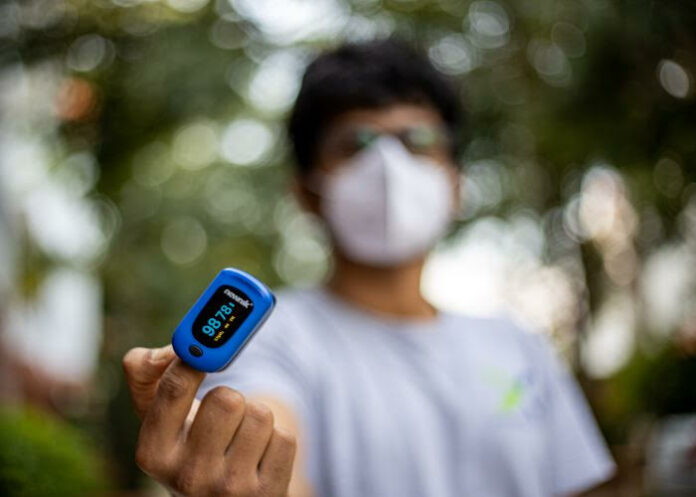Pulse oximetry is a standard use technology with applications in both ambulatory and inpatient settings, but despite its widespread use, there have been reports, from as early as 1990, of variation in device accuracy relating to a person’s race in critically ill patients.
Recent investigations have documented differential accuracy in pulse oximetry measurement between black and white patients in intensive care units and in critically ill patients with respiratory failure, with black patients having a higher prevalence of occult hypoxaemia than white patients. This difference, said the researchers, from the University of Michigan, US, could limit access to supplemental oxygen and other more intensive support and treatments for black patients.
Occult hypoxaemia is defined as a low saturation of arterial blood gas (that is, SaO2 <88%) despite seemingly normal pulse oximetry (that is, SpO2 ≥92%). Among critically ill patients, patients with occult hypoxaemia detected by arterial blood gas but missed by pulse oximetry have recently been shown to have worse clinical outcomes by detailed analyses – including higher mortality and greater incidence of organ failure – as might be expected, given the central role of oxygen delivery in healthy cellular functioning.
Policy and regulatory interest over the technology has increased, and independent expert bodies have called for additional research in the subject. However, several pressing gaps in the research limit the bedside application of existing data. First, most patients in hospital are not critically ill, and it is unclear whether pulse oximetry bias observed in critically ill patients can be generalised to less acute settings.
Second, many laboratory studies have focused on the accuracy of pulse oximeter readings with SpO2 <85%. If concerns about occult hypoxaemia and pulse oximeter bias do not apply to less ill patients with SpO2 readings of ≥92%, acting on existing data could lead to unnecessary invasive measurement of arterial blood gases or unnecessary expenditures on new pulse oximeters.
Finally, while SpO2-SaO2 discrepancies are more common in black patients than in white patients, the stability of such discrepancies within an individual patient is unclear. Thus, if a clinician has documented such a discrepancy (or its absence) and the same patient later shows signs or symptoms compatible with arterial hypoxaemia, the next step is unclear: whether to repeat an arterial blood gas measurement, or to assume the same direction and magnitude of the SpO2-SaO2 discrepancy as recently documented.
The study group sought to correct these gaps in this study of medical and surgical inpatients in general care in the Veterans Health Administration, a large and diverse health system serving veterans across the US.
They hypothesised that black patients in general care (that is, not in intensive care) would have an increased frequency of occult hypoxaemia compared with white inpatients in general care. They also hypothesised that a blood gas measurement showing the absence of occult hypoxaemia would be associated with a low probability of occult hypoxaemia on subsequent arterial blood gases, and that this probability would not vary by race. As in past work, they analysed spontaneously recorded SpO2-SaO2 measurements collected during routine care from inpatients in the Veterans Health Administration from 2013 to 2019.
Study details
Racial bias and reproducibility in pulse oximetry among medical and surgical inpatients in general care in the Veterans Health Administration 2013-19: multicenter, retrospective cohort study
Valeria Valbuena, Sarah Seelye, Michael Sjoding, Thomas Valley, Robert Dickson, Steven Gay, Dru Claar, Hallie C Prescott, Theodore Iwashyna.
Published in BMJ on 6 July 2022.
Abstract
Objectives
To evaluate measurement discrepancies by race between pulse oximetry and arterial oxygen saturation (as measured in arterial blood gas) among inpatients not in intensive care.
Design
Multicentre, retrospective cohort study using electronic medical records from general care medical and surgical inpatients.
Setting
Veteran Health Administration, a national and racially diverse integrated health system in the United States, from 2013 to 2019.
Participants
Adult inpatients in general care (medical and surgical), in Veteran Health Administration medical centres.
Main outcomes measures
Occult hypoxaemia (defined as arterial blood oxygen saturation (SaO2) of <88% despite a pulse oximetry (SpO2) reading of ≥92%), and whether rates of occult hypoxaemia varied by race and ethnic origin.
Results
A total of 30 039 pairs of SpO2-SaO2 readings made within 10 minutes of each other were identified during the study. These pairs were predominantly among non-Hispanic white (21 918 (73.0%)) patients; non-Hispanic black patients and Hispanic or Latino patients accounted for 6498 (21.6%) and 1623 (5.4%) pairs in the sample, respectively.
Among SpO2 values greater or equal to 92%, unadjusted probabilities of occult hypoxaemia were 15.6% (95% confidence interval 15.0% to 16.1%) in white patients, 19.6% (18.6% to 20.6%) in black patients (P<0.001 v white patients, with similar P values in adjusted models), and 16.2% (14.4% to 18.1%) in Hispanic or Latino patients (P=0.53 v white patients, P<0.05 in adjusted models).
This result was consistent in SpO2-SaO2 pairs restricted to occur within 5 minutes and 2 minutes. In white patients, an initial SpO2-SaO2 pair with little difference in saturation was associated with a 2.7% (95% confidence interval −0.1% to 5.5%) probability of SaO2 <88% on a later paired SpO2-SaO2 reading showing an SpO2 of 92%, but black patients had a higher probability (12.9% (−3.3% to 29.0%)).
Conclusions
In general care inpatient settings across the Veterans Health Administration where paired readings of arterial blood gas (SaO2) and pulse oximetry (SpO2) were obtained, black patients had higher odds than white patients of having occult hypoxaemia noted on arterial blood gas but not detected by pulse oximetry. This difference could limit access to supplemental oxygen and other more intensive support and treatments for black patients.
See more from MedicalBrief archives:
Pulse oximeters deliver unreliable readings across ethnic groups
UK investigation into racial and gender bias in medical devices
200-year-old race-based COPD diagnostic formula shown to be inadequate
US paediatricians’ association to bin outdated race-based guidelines
COVID toll turns spotlight on Europe’s taboo on data by race

